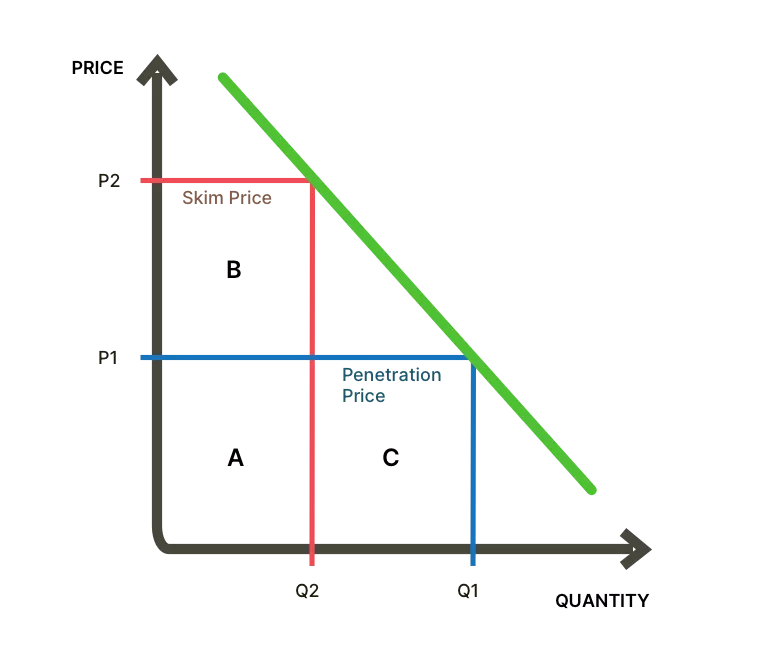So, you’re about to unleash your brilliant product into the world.
Hell yeah. But before diving straight into it, let me give you a quick and easy plan so you don’t mess up.
A successful product launch is all about the biggest growth in the shortest possible time, and potential customers NEED to be attracted to the product.
How do you do that?

Don’t dilute your efforts by trying to do everything. Focus on identifying and prioritizing the most impactful actions for your specific situation.
Get into your customers’ heads: analyze your ideal customer’s journey and pinpoint the areas where your product offers the most significant value or solves a critical pain point. By concentrating your resources and messaging on these key areas, you create a more focused and effective product launch strategy.
This guide is packed with no-nonsense advice to help you navigate the product launch maze, avoid epic fails, and keep your sanity intact (mostly).
“… does it really matter? Just get on with it.” – you might be protesting.
But yes. It does matter because it puts into perspective the bigger picture and the steps required to execute it.
A product launch strategy is the bigger picture. This involves:
On the other hand, a product plan is the… well… plan to execute the strategy. It’s basically the “how” and “when”. It includes:
I’m talking about my free Startup Launch Roadmap eBook.
It’s a step-by-step guide designed to show you how to build a product or service, launch it, and keep scaling as long as you want to.
If you’re an entrepreneur in ANY industry… you’ll find it really useful (plus it’s free!):
We’re not writing this down for no reason. As a product owner, a written product launch strategy lets you switch on your imagination and play different scenarios in your head before they actually happen.
This will let you see some edge cases: What can go wrong? What am I missing? What else will be needed from me?
If you can prepare yourself and all the materials (product descriptions, emails, landing pages, etc.) ahead of time, the execution stage will be ten times easier… and more successful.
To make sure your product launch goes off like Mentos in Cola, and not a lead balloon, we have a complete guide below of what to include in your strategy. But at the end of the day just three things are going to do a lot of the heavy lifting: building anticipation, targeting the right audience and choosing the optimal pricing approach.

Rookie mistake #1 is thinking that the launch is just about that one glorious day when you hit “publish” and celebrate. Wrong!
The real magic happens way before you even think about unleashing your masterpiece on the unsuspecting masses. But if you need to cut corners, run through the following activities quickly and draw up a brief plan.
First things first, who the heck are you trying to reach? And no, “everyone” is not an acceptable answer (unless you’re selling oxygen… maybe).
Get crystal clear on your ideal customer. What are their pain points? What keeps them up at night? What are their wildest dreams (related to your product, of course)?
Once you know who you’re targeting, you can tailor your messaging, marketing channels, and even your product features to hit them right where it hurts… in a good way, of course.
This should really be done before developing your product, which you can read about in our fantastic article on creating products that customers will love, but at the launch stage, it’s important to do it again and refresh your plans.
What makes your product the Beyoncé of its industry? Why should customers choose you over the sea of other wannabe superstars?
This is where your Unique Selling Proposition (USP) struts its stuff. It’s that irresistible je ne sais quoi that sets you apart from the competition and makes customers drool with desire.
Think: what problem do you solve better, faster, or sexier than anyone else? That’s your USP, baby! Now shout it from the rooftops (or at least plaster it all over your website and marketing materials).
Map out the customer’s complete journey for each stage of the buying cycle and address their needs accordingly.
Analyze your competitors, target audience, and relevant keywords to understand the market landscape.
Determine your brand’s position in the market and how it compares to competitors.
Identify platforms and channels where your target audience is active and engage with them.
Compile a list of publications, influencers, and thought leaders relevant to your industry for potential collaboration.
Craft a compelling brand message that resonates with your audience and highlights the value proposition of your product. Ask yourself: Why are we doing this? Align the product launch with the overall business goals to ensure it’s not just a vanity project.
Again, this should have been done before product development, so it’s time to do a quick refresh.
Create content and press releases to raise awareness and generate interest in your product before launch. This and the following activities definitely come after product development and are the backbone of your pre-launch preparations.
Develop a comprehensive content strategy that addresses customer questions, provides valuable information, and promotes your product to the max.
Use visually appealing infographics to explain your product, its benefits, and use cases.
Plan your content strategy and ensure consistent publication of valuable content.
A truly great strategy covers every single base. Though you don’t have to do all of them and some might not be relevant to your business, consider these pro tips:
And get the 8D Framework eBook where I’ve summarized the whole process of launching a new business, with detailed steps and a nice diagram.
If you want your launch to fail miserably, get your pricing strategy all wrong. Yes, price is pretty important. It needs to be based on something, like what your competitors are charging or the perception of value customers have of the product. But there are a couple of strategies that are useful to go with so you can optimize profits from day 1:
Price skimming involves setting a high initial price for a new product to maximize revenue from early adopters willing to pay a premium. The price is then gradually lowered to capture additional market segments.
This strategy is most effective when:
A great example is Apple’s initial high price for the first iPhone, followed by price reductions to attract new buyers.
Market penetration pricing involves setting a low initial price for a new product to quickly gain market share. This strategy sacrifices short-term profitability for long-term growth.
It is most effective when:
A great example of a real company using this is Ikea’s low prices for furniture, attracting a large customer base and achieving economies of scale.

The best product launch strategy depends on various factors, including the characteristics of your product, market conditions, and company goals. You’ll need to weigh up the advantages and limitations of each strategy before making a decision.
How you communicate to your target audience is all about marketing. Get product marketing right, and you’re halfway there to making the launch a success.

Product marketing involves bringing a product to market and keeping customers informed about it. It encompasses everything from product messaging and branding to launch strategies and post-launch support.
Yes, you want your launch to go perfectly, but you want to keep that momentum going post-launch too.
These are some of the goals of product marketing:
Spanx
Sara Blakely’s brand messaging transformed the company’s shapewear from a mundane product to a source of confidence and empowerment. Blakeley’s product marketing strategy was to be offensive and loud, to make women feel excited about their bodies.
Blakeley could never have made billions selling shapewear; she made money by selling a vision that the audience and customer base believed in. Blakeley changed the way women thought about underwear and revolutionized an industry just with her messaging and branding.
Do you have the communication skills to effectively get your message out and ensure that others understand your product and its benefits?
Disney
Bob Iger’s focus on brand integrity and strategic acquisitions revitalized Disney’s image and market value.
Disney had lost its shine and may have gone bankrupt after a legacy that spanned decades. However, Bob Iger immediately set to work on preserving Disney’s brand identity. He cut all marketing that cheapened the Disney brand and stopped allowing the company to make cheap or demeaning movies. He purchased other companies that would improve the image of the brand, including Star Wars, Pixar, and Marvel.
Don’t you want to be a bit like Blakely and Iger? Well, make sure you don’t fall into the traps thousands of entrepreneurs find themselves in time and time again:
Launch day is all about turning up the volume of your marketing efforts. We’re talking social media blitzkrieg, email blasts, influencer shoutouts — the whole shebang.

Remember all that pre-launch buzz you built? Now’s the time to convert those curious onlookers into paying customers. Hit them with irresistible offers, early bird discounts, or exclusive content that they won’t find anywhere else.
There are some KPIs you should really focus on to know if you really hit the jackpot:
The launch might be over, but your marketing efforts shouldn’t be. Keep the momentum going with regular content, promotions, and engagement.
Remember, acquiring new customers is awesome, but keeping those existing ones happy is where the real magic happens. Build relationships, nurture your community, and turn those one-time buyers into loyal fans who rave about you to everyone they meet (and their dog).
To keep the momentum going after the launch, think about doing some of these:
A successful product launch strategy is made up of a number of elements. By focusing on those, you’re learning who your target audience is and what will attract them to your product, you’re creating marketing that creates a buzz, and you’re working out the optimum price to generate high demand while keeping a healthy profit margin.
Your customers are a goldmine of valuable insights. Pay attention to their feedback, both good and bad (especially the bad). What do they love about your product? What makes them want to tear their hair out? Use their feedback to improve your product, refine your messaging, and give your customers exactly what they want (even if they don’t know they want it yet).
Having the right pricing strategy for the product launch will do wonders for your bank account, but make sure your decision on which one to use is based on real customer needs, the specifics of your company, and the overall market environment.
Product marketing. Yes, it’s a thing. Take it seriously. From brand awareness to post-launch marketing campaigns, you want to cover the whole journey from product development in the pre-launch stage, all the way through to generating repeat customers who advocate for your company.
Business begins where slogans end and numbers appear. While slogans and marketing messages are crucial for creating initial buzz, sustainable success relies heavily on analyzing metrics, such as customer acquisition cost, lifetime value, and conversion rates. I’ve summarized these steps too in the 8D Framework eBook.
DON’T BE A MARKETING MORON. Avoid the pitfalls that make companies throw money down the drain, sound boring, or turn people off completely. The startup world is constantly changing, so DON’T be afraid to PIVOT your strategy, your product, or even your entire business model if you need to. Being agile and adaptable is key to staying ahead of the curve and achieving long-term success.

Email subscription is available ONLY TODAY (oh, okay, and tomorrow).
Surely, we respect your inbox! Unsubscription works every day.

We’d love to tailor your experience — which of these best describes you?